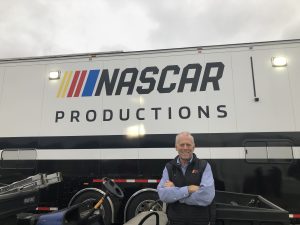Steve Stum of NASCAR Productions on the Challenge of Getting Back to Racing in the Age of COVID 19
Story Highlights
Steve Stum, NASCAR Productions, vice president, operations and technical production, has been at the track for plenty of dramatic moments both on and off the track. Following 9/11 he recalls walking into the compound for the first race afterwards and the eerie feeling of attempting to return to normal following the terrorist attacks. This weekend will be another such moment but, due to the Coronavirus pandemic, he won’t be on the track but rather watching it like the rest of us: on TV. “There is no precedent for this, but I will be sitting on the edge of the couch watching it on Sunday with goosebumps because the world is going to be watching,” he says. “All Americans rally around sports and this is a glimmer of light and it’s great to have Fox as partners on something that gives a little bit of hope.”

Steve Stum and the NASCAR Productions team have been working hard for an upcoming slate of 11 races in 21 days.
On Sunday when NASCAR returns to the track in Darlington, SC, Stum won’t be at the track as the goal is to have as few people as possible at the track. But he will be watching from home, capping off what he says is the busiest stretch of work he has ever experienced as NASCAR, working along with Fox Sports, track officials, and all of the racing teams, shifted into overdrive to figure out a plan to get NASCAR back in action.
The big challenge for Sunday is ensuring that everyone fully in not only the TV production teams but also the racing teams, venue personnel, and NASCAR officials stay disciplined but also work towards a plan. Stum has been clear to everyone on site that taking more time to do less work is fine as even tasks like running fiber take a new level of mental processing to accomplish.
“It takes more time to do less work and everyone also has to get used to wearing masks, gloves, or shields to protect themselves and the people around them,” says Stum. “You can’t let your guard down and it takes a lot more thinking because you don’t have your normal rhythm and routine.”
Key to the planning efforts was working with medical professionals who provided advice on how to approach things like check in points, testing, and more. For example, NASCAR, like most sporting events, typically has multiple areas of access points both into the stadium and then between different areas.
“We are locking down the facility and just have two entrances where everyone is checked as the come in,” says Stum. That eliminates the need for people to potentially be tested multiple times during the day.
An example of how the TV production is being impacted was the installation of in-car cameras by BSI. Having no on-board cameras was considered but they are such a big part of the coverage and viewers expect them, so the decision was made to get them installed in the cars.
“The BSI guys had to wear face shields and gloves and we also didn’t install cameras on the cockpit side so they wouldn’t get near where the driver will be,” says Stum. “Things like that required a lot of changes and thought.”
The NASCAR facility in Charlotte, NC, will have about 40 people in the building on race day handling the international feeds with a team that is following CDC social distancing and PPE guidelines (and also taking advantage of some of the open control rooms so they can be split apart even further). The Fox announcers will also be on site.
“The hard part will be doing 11 shows in 21 days, but you need to trust everyone to understand how important this is,” says Stum. “There’s been a lot of good collaboration and this is one of those times proud to work for a company like NASCAR as we look to be the first ones back.”
